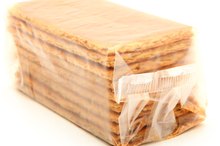What does fact checked mean?
At Healthfully, we strive to deliver objective content that is accurate and up-to-date. Our team periodically reviews articles in order to ensure content quality. The sources cited below consist of evidence from peer-reviewed journals, prominent medical organizations, academic associations, and government data.
The information contained on this site is for informational purposes only, and should not be used as a substitute for the advice of a professional health care provider. Please check with the appropriate physician regarding health questions and concerns. Although we strive to deliver accurate and up-to-date information, no guarantee to that effect is made.
Beignet Nutrition
Before the doughnut, there was the beignet, according to What's Cooking America 1. A beignet is made from raised pieces of yeast dough that have been fried, then sprinkled with sugar or smeared with icing. Although the beignet is lower in fat and calories than a doughnut, it is still considered a sweet treat that you should not eat everyday if you are following a heart-healthy diet.
Calories
Calories in food indicate the amount of energy it supplies. Eating more calories than you can use causes your body to store the extra energy as fat. Most adults can maintain a healthy weight eating 1,800 to 2,000 calories a day. One 2 oz. beignet contains 147 calories. In comparison, one sugared cake doughnut contains 192 calories 2.
- Calories in food indicate the amount of energy it supplies.
Fat
Farmer Cheese Nutrition
Learn More
One 2 oz. beignet contains 1 g of total fat and 0 g of saturated fat. A traditional sugared cake doughnut contains 10 g of total fat and 2.6 g of saturated fat 2. The USDA's dietary guidelines suggest you limit your daily fat intake to 20 to 35 percent of total calories, and saturated fat to less than 10 percent of total calories. On a 2,000-calorie diet that means 44 to 78 g of total fat a day and no more than 22 g of saturated fat a day.
- beignet contains 1 g of total fat and 0 g of saturated fat.
- A traditional sugared cake doughnut contains 10 g of total fat and 2.6 g of saturated fat 2.
Carbohydrates
One beignet contains 30 g of carbohydrates and 1 g of fiber. Most of your calories should come from carbohydrates because they serve as the primary source of fuel for your body. A balanced diet should contain 45 to 65 percent of its calories from carbohydrates, which means that on a 2,000-calorie diet, your carbohydrate intake should range from 225 to 325 g per day. Fiber is a type of carbohydrate your body cannot digest. It can help control hunger and alleviate constipation. The beignet is not a significant source of fiber. Healthy women should try to eat 21 to 25 g of fiber a day, and healthy men 30 to 38 g of fiber per day.
- One beignet contains 30 g of carbohydrates and 1 g of fiber.
- A balanced diet should contain 45 to 65 percent of its calories from carbohydrates, which means that on a 2,000-calorie diet, your carbohydrate intake should range from 225 to 325 g per day.
Protein
Calories in a Slice of Whole-Grain Bread
Learn More
One beignet contains 4 g of protein. A balanced diet should contain 10 to 35 percent of its calories from protein. Your body uses the protein in foods to help rebuild tissue and maintain its muscle mass. Adequate intakes of protein also support your immune system.
- One beignet contains 4 g of protein.
- Your body uses the protein in foods to help rebuild tissue and maintain its muscle mass.
Sodium
One beignet contains 80 mg of sodium. In comparison, one sugared cake doughnut contains 181 mg of sodium 2. High intakes of sodium can increase your risk of high blood pressure. The USDA recommends that you limit your daily sodium intake to less than 2,300 mg a day.
- One beignet contains 80 mg of sodium.
- The USDA recommends that you limit your daily sodium intake to less than 2,300 mg a day.
Related Articles
References
Writer Bio
Jill Corleone is a registered dietitian and health coach who has been writing and lecturing on diet and health for more than 15 years. Her work has been featured on the Huffington Post, Diabetes Self-Management and in the book "Noninvasive Mechanical Ventilation," edited by John R. Bach, M.D. Corleone holds a Bachelor of Science in nutrition.









